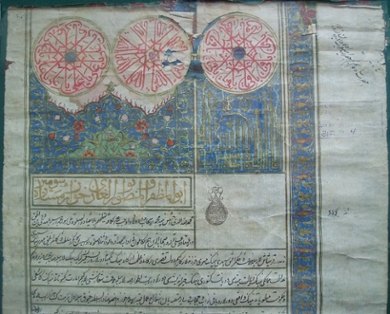Sanjar Golomov is a senior scholar at the Al-Biruni Institute in Tashkent, Uzbekistan. In Leiden he will deliver two lectures and one masterclass for MA and PhD students as part of the Erasmus Mobility Plus project between Leiden University and the Al-Biruni Institute. The project is coordinated and hosted by the Central Asia Initiative at Leiden University.
Sanjar Gulomov
Sanjar Golomov is a senior scholar at the Al-BiruniInstitute in Tashkent, Uzbekistan. He has supervised the creation of an electronic catalogue of the manuscript fund of the Institute, a project funded by the Gerda Henkel Foundation, Germany. Sanjar Gulomov studied Persian and has published several translations and editions of Persian manuscripts from the Al-Biruni collection.

Lecture on Monday, 10 December: Central Asian historical documents: types and peculiarities
Time: 15:15-17:00 hrs
Venue: M. de Vrieshof 4, Room 007
The manuscript collection of the Al-Biruni Institute of Oriental Studies in Tashkent, Uzbekistan contains a large quantity of historical documents in Persian, Turkic and Arabic drafted on the territory of the Central Asian khanates. These include legislative documents (decrees, orders, and instructions), private legal documents (documents concerning sales, wills, marriage certificates, deeds of gift, leases, mortgages, waqf promissory notes), clerical documents (orders, notices, and petitions), and other legal documents.

Masterclass on Wednesday, 12 December: Manuscripts of mixed content - Miscellany, Varia: who were their customers and why were they created?
Time: 9:30-12:00 hrs
Venue: Lipsius, Room 001
Manuscripts containing large and small fragments from various works are usually recorded in catalogues in the sections «Miscellany», «Miscellanea» or “Manuscripts of mixed content”. In the manuscript catalogues published in the Soviet period, the term «Varia was preferred. In general, western catalogues provide a more detailed description of all contents of such collections. As a result, even small fragments and author names are reflected in the indexes. On the contrary, in many Central Asian catalogues, the structure of the collections is described shortly, frequently superficially in the section «Varia». Thus titles and author names have been omitted. It is clear that the description of such collections (identification of their compositions, author information, copies of epistolary sources, various records, etc.) requires a lot of time and effort on behalf of the cataloger. Yet, these collections can contain valuable information, which cannot be found in other sources.
Registration
If you would like to attend the masterclass, please register with Elena Paskaleva at: This email address is being protected from spambots. You need JavaScript enabled to view it.

Lecture on Thursday, 13 December: On a type of administrative documents of the Bukharan Emirate issued by the late Manghit rulers: letters – orders. What changes have occurred in the external attributes and in the internal form of the documents?
Time: 13:15-15:00 hrs
Venue: M. de Vrieshof 2, Room 002
Orders and decrees of governors (khans, emirs) are of great value within the Central Asian archival materials. Traditionally, these types of documents are known as yarliq. The majority of the yarliqs have an extraordinary external form and were written eloquently. But there are also exceptions, which offer new research possibilities. In the decrees and orders of the Bukharan emirs issued in the 19th and at the beginning of the 20th centuries, we can observe changes both in the external and in the internal form of the documents. Therefore, certain Bukharan decrees have been referred to as "Letter -order" instead of "yarliq". The governor’s seal has an important place on the yarliq.Usually, they were imprinted in the top right corner of the document, near the initial lines of the text. In the orders of the Bukharan Emirate, issued by late Manghit rulers, the seals were imprinted on the verso side of the document.


